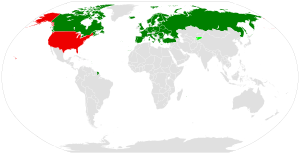Treaty on Open Skies


The Treaty on Open Skies began on January 1, 2002, and currently has 34 party states. It created a program of unarmed aerial surveillance flights over the entire territory of its participants.
The treaty is designed to help create a mutual understanding and confidence by giving all participants the ability to gather information about military forces and activities of concern to them.
The idea of "mutual aerial observation" was proposed to Soviet Premier Nikolai Bulganin at the Geneva Conference of 1955 by U.S. President Dwight D. Eisenhower. The treaty was eventually signed as an initiative of U.S. president George H. W. Bush in 1989. The agreement was signed in Helsinki, Finland, on March 24, 1992. The United States officially withdrew on 22 November 2020.[1]
Flight Quotas[change | change source]
Each state-party must accept a set number of overflights annually, called its passive quota, roughly based on its size. The active quota allows a state-party to conduct flights over others. Each state-party can conduct an equal number of flights over others as those over it. A state's active quota can't exceed its passive quota, and no single state can request more than half of another's passive quota. The treaty allows multiple states to join in an overflight, counting it as active for each participant but passive for the observed state. Russia's first observation flight was in August 2002, the US in December of the same year. The 500th overflight was celebrated in 2008, with over 1,500 flights between 2002 and 2019.[2]
Provisions[change | change source]
An observing state-party must provide 72 hours' notice before arriving in the host country for an overflight. The host has 24 hours to acknowledge the request and determine if the observing party can use its own plane or one supplied by the host. The observing party must submit its flight plan at least 24 hours before the flight, which the host reviews within four hours. Changes to the plan can only be made for safety or logistical reasons, with both parties given eight hours to agree on changes or the flight is cancelled. The observation mission must be completed within 96 hours of the observing party's arrival, unless otherwise agreed upon.
While state-parties can overfly all of a member's territory, the treaty specifies entry and exit points and refueling airfields. It also sets ground resolution thresholds for onboard cameras and sensors, which must undergo certification to ensure compliance.[3]
References[change | change source]
- ↑ "United States formally withdraws from Open Skies treaty - US & Canada". Al Jazeera. 2020-11-22. Retrieved 2020-11-22.
- ↑ "The Open Skies Treaty at a Glance | Arms Control Association". www.armscontrol.org. Retrieved 2024-04-30.
- ↑ "OPEN SKIES TREATY (8) - THE PRINCIPAL INTERNATIONAL ARMS CONTROL CONVENTIONS". www.europarl.europa.eu. Retrieved 2024-04-30.